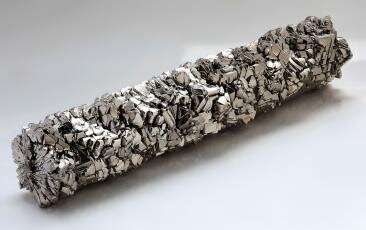New clues about an elusive material: A superconductor that can be synthesized in the lab

Titanium monoxide (TiO), an inorganic chemical compound, is a material that has eluded close study by physicists due to a dearth of high-purity single crystal samples. A team of researchers, though, has now been able to synthesize and examine high-quality TiO and finds that this material has some surprising properties.
The research team, which includes scientists from Yale, University of British Columbia, University of Chinese Academy of Sciences, and Brookhaven National Laboratory, finds that TiO acts as a superconductor—a material that can transport electrons with no resistance—at a temperature close to minus 273 degrees Celsius. Superconductivity distinguishes it from other materials in the monoxide family. The results are published in Science Advances.
"The fact that it's a superconductor is surprising, because superconductivity is rare in oxides with just one oxygen per metal atom," said co-author Sangjae Lee, a graduate student in the lab of Charles Ahn, the John C. Malone Professor of Applied Physics and department chair. "We find that it is very close to the superconducting behavior of titanium metal itself."
TiO is made up of a single oxygen that binds in between the titanium atoms. Conventional thinking predicts that the bond between titanium and oxygen is responsible for much of the material's interesting physics, but a closer look reveals that the titanium itself is a key driver for the electronic properties.
One reason TiO hasn't been studied more is because it's so difficult to get high-quality samples. Using a material growth method known as molecular beam epitaxy, however, the research team is able to synthesize a high-purity sample of the material to study.
"Compared to other growth methods, molecular beam epitaxy is flexible enough to stabilize phases that can't be synthesized any other way," Lee said.
Once they had a high-purity sample, they used a number of experimental and theoretical techniques to study it and acquire information about its electronic behavior and structure.
"By combining all of the experimental data with theory, we are able to determine that the very interesting superconducting behavior comes from the nature of the titanium-titanium bonding in this material.
Now that they've synthesized TiO, Lee said there are numerous pathways to elucidate the relationship between the structure and electronic behavior of other similar classes of superconducting oxide materials.
"It reveals many important directions that the community can take," he said.
More information: Fengmiao Li et al. Single-crystalline epitaxial TiO film: A metal and superconductor, similar to Ti metal, Science Advances (2021). DOI: 10.1126/sciadv.abd4248
Journal information: Science Advances
Provided by Yale University





















